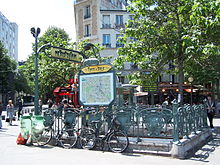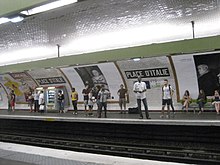Place d'Italie (Paris Metro)
|
|
|
|---|---|

|
|
| Tariff zone | 1 |
| Line (s) |
|
| place | 13th arrondissement |
| opening | April 24, 1906 |


The subway station Place d'Italie is an underground interchange of the lines 5 , 6 and 7 of the Paris Metro . It is an important transfer hub in the south of Paris , with around 36,000 passengers a day, in 2004 it was one of the ten most heavily frequented stations on the Metro.
location
The metro station is located on Place d'Italie, where the borders of all four quarters of the 13th arrondissement meet. The stations of lines 5 and 7 are located under the circular square, the station of line 6 is on its southeast side under the confluence of the Boulevard Vincent-Auriol.
Surname
It is named after the Place d'Italie . This is where the Roman road leading from Rome via Lyon to ancient Lutetia ended . Today the Route nationale 7 begins there , which runs from Paris to Menton on the border with Italy (fr: Italie).
history
The station of today's line 5 was put into operation on April 24, 1906 with the opening of the southern extension of line 2 Sud (today line 6) from Passy . The latter operated from Étoile to Place d'Italie. On June 2, 1906, the first section of line 5 (Place d'Italie - Gare d'Austerlitz ) went into operation. It shared the double-track Place d'Italie station, which was provided with a central platform , with line 2 Sud, but this led to mutual hindrances. This state of affairs did not end until May 1907, when the station under the confluence of Boulevard Vincent-Auriol , which was completed with a view to the planned continuation of line 2 Sud to Nation , was put into operation for this line. On October 17, 1907, this station was shut down again for a year and a half, as on that day line 2 Sud merged with line 5. The new line 5 (Étoile - Place d'Italie - Gare du Nord ) was the longest on the network until October 1942.
On March 1, 1909, line 6 was opened between Place d'Italie and Nation, the southwest end point of which was Place d'Italie station of the former line 2 Sud, which was only used for almost six months in 1907. The section of line 5 from Place d'Italie to Étoile was temporarily assigned to line 6 during the colonial exhibition from May 17 to December 6, 1931 and permanently assigned to October 6, 1942. Since then, the underground station has been the southern terminus of line 5.
On February 15, 1930, the station of line 7 was added, which was temporarily used by line 10. At that time, line 10 ran from Invalides via Duroc to Cardinal Lemoine and from there it was routed to the section Place Monge - Place d'Italie - Porte d'Italie , which was already completed but not yet used by line 7 . This condition lasted until April 26, 1931, when the opening of the crossing under the Seine allowed this section of the route to be connected to Line 7.
description
All three stations are under elliptical , white tiled vaults, the side walls of which follow the curvature of the ellipse. At 75 m, the stations on lines 5 and 6 have the original Parisian standard length, while the station on line 7 is 105 m long - enough for seven cars. The station of line 5 is in a curve and has a central platform, the other two stations are straight and have side platforms . While the stations of lines 5 and 6 are offset lengthways next to each other under the southern part of the square and (line 6) the confluence of the Boulevard Vincent Auriol, their tracks are underpassed by line 7, whose station is under the center of the square, almost at right angles.
Line 5 has an end loop under the square , which it shared with line 2 south until May 1907. The terminus is located within this formerly completely double-track loop, at its southernmost point. The loop was no longer used as such in regular services for decades. The arriving trains drove in via platform 2, turned after the passengers got off the station on platform T and began their return journey on platform 1. In the summer of 2007, the facilities were changed so that the End loop can be used as such again.
Tracks 2, T and G (inner loop track) form a closed circle, from which a track branches off to the Ateliers d'Italie workshop , which was opened in 1906 and is located about 200 m above ground west of Rue Abel Hovelacque. Since the Ateliers de Bobigny opened in the north of Line 5 in 1988 , Ateliers d'Italie have only been responsible for maintaining the trains on Line 6. This line is reached via an operating track that includes the former outer loop track and on which there is a washing facility for the trains.
There are track connections between all three lines which are only used for internal purposes. A short track west of the line 5 station leads to line 6, two longer tracks link lines 5 and 9 under Place d'Italie and 6 and 9 under Avenue d'Italie, which branches off to the south.
There are four entrances from the street, two of which feature the Art Nouveau style decor designed by Hector Guimard . Another is marked by a candelabra designed by Adolphe Dervaux in the style of Art Deco .
vehicles
Trains with wooden superstructures ran on line 2 Sud, which consisted of two approximately 8 m long, two-axle railcars and six similar trailer cars .
On line 5, four-car, later five-car trains of the Sprague-Thomson design, resting on bogies , ran . From 1978 they were replaced by vehicles from the MF 67 series , which were followed by MF 01 trains from 2011 .
Line 6, on which Sprague-Thomson trains were also used, was converted to rubber-tired vehicles in July 1974 . Since then, there have been trains from the MP 73 series made up of three multiple units and two trailer cars .
Conventional five-car trains of the MF 77 series run on Line 7 . Between 1971 and 1979 trains of the MF 67 series ran there, before that of the Sprague-Thomson type.
Remarks
- ↑ Since line 2 was originally planned as a circular railway, but was not designed as such, its line number initially existed twice as lines 2 north (today's line 2 ) and 2 south
- ↑ At the same time, line 10 was swiveled from the Cardinal Lemoine station to the Jussieu underground station (transfer station with line 7)
- ↑ Due to the short length of numerous other stations, only five-car trains run on Line 7
- ↑ A railcar with a one-sided driver's cab runs at each end of the train, with a driverless cab and two non-motorized sidecars in between
Web links
- Plan of the tracks and platforms at carto.metro.free.fr
literature
- Gérard Roland: Stations de métro. D'Abbesses à Wagram . 2003, ISBN 2-86253-307-6 .
Individual evidence
- ↑ Sommaire. (PDF; 1.1 MB) (No longer available online.) P. 16 , archived from the original on June 17, 2012 ; Retrieved July 16, 2010 (French). Info: The archive link was inserted automatically and has not yet been checked. Please check the original and archive link according to the instructions and then remove this notice.
- ^ Jean Tricoire: Un siècle de métro en 14 lignes. De Bienvenüe à Météor . 2nd Edition. La Vie du Rail, Paris 2000, ISBN 2-902808-87-9 , p. 202 .
- ^ Gérard Roland: Stations de métro d'Abbesses à Wagram . Christine Bonneton, Clermont-Ferrand 2011, ISBN 978-2-86253-382-7 , pp. 162 .
- ^ Christoph Groneck: Metros in France . 1st edition. Robert Schwandl, Berlin 2006, ISBN 3-936573-13-1 , p. 22 .
- ↑ Jean Tricoire: op.cit. P. 197 f.
- ↑ Jean Tricoire: op.cit. P. 210.
- ↑ a b Jean Tricoire: op.cit. P. 225.
- ^ Brian Hardy: Paris Metro Handbook . 3. Edition. Capital Transport Publishing, Harrow Weald 1999, ISBN 1-85414-212-7 , pp. 36 .
- ↑ Jean Tricoire: op.cit. P. 202.
- ↑ Jean Tricoire: op.cit. P. 199.
- ↑ Jean Tricoire: op.cit. P. 337.
- ^ Gérard Roland: op.cit. P. 114 f.
- ↑ Jean Tricoire: op.cit. P. 84 f.
- ↑ Jean Tricoire, op. Cit. P. 198.
- ↑ Jean Tricoire: op. Cit. P. 227 and 245.
| Previous station | Paris metro | Next station |
|---|---|---|
|
Campo-Formio ← Bobigny - Pablo Picasso |
|
final destination |
|
Corvisart ← Charles de Gaulle - Étoile |
|
National nation → |
|
Les Gobelins ← La Courneuve - May 8, 1945 |
|
Tolbiac Mairie d'Ivry or Villejuif - Louis Aragon → |
Coordinates: 48 ° 49 ′ 53 " N , 2 ° 21 ′ 20.2" E


